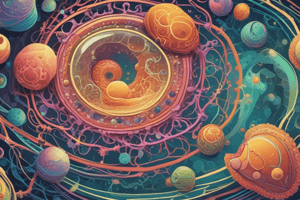Podcast
Questions and Answers
What is the primary function of the nucleus in a cell?
What is the primary function of the nucleus in a cell?
- Protein synthesis
- Waste removal
- Energy production
- Control center containing DNA (correct)
Which organelle is primarily involved in ATP production?
Which organelle is primarily involved in ATP production?
- Ribosomes
- Lysosomes
- Golgi Apparatus
- Mitochondria (correct)
Which of the following statements about ribosomes is correct?
Which of the following statements about ribosomes is correct?
- They translate mRNA into amino acid sequences. (correct)
- They are only found attached to the Golgi Apparatus.
- They are involved in lipid synthesis.
- They contain a double membrane.
What is the function of the Golgi Apparatus?
What is the function of the Golgi Apparatus?
What distinguishes smooth endoplasmic reticulum from rough endoplasmic reticulum?
What distinguishes smooth endoplasmic reticulum from rough endoplasmic reticulum?
What role do lysosomes play within a cell?
What role do lysosomes play within a cell?
Which organelle is responsible for detoxification and breakdown of fatty acids?
Which organelle is responsible for detoxification and breakdown of fatty acids?
What is a major function of vacuoles in plant cells?
What is a major function of vacuoles in plant cells?
Which component is a part of the cytoskeleton?
Which component is a part of the cytoskeleton?
What is primarily responsible for the rigidity of plant cells?
What is primarily responsible for the rigidity of plant cells?
Flashcards
Nucleus
Nucleus
The control center of the cell, containing the cell's DNA and responsible for directing cellular activities.
Mitochondria
Mitochondria
Double-membrane organelles responsible for generating energy in the form of ATP through cellular respiration, often called the 'powerhouses' of the cell.
Ribosomes
Ribosomes
Tiny organelles essential for protein synthesis, reading mRNA to assemble proteins.
Endoplasmic Reticulum (ER)
Endoplasmic Reticulum (ER)
Signup and view all the flashcards
Golgi Apparatus
Golgi Apparatus
Signup and view all the flashcards
Lysosomes
Lysosomes
Signup and view all the flashcards
Vacuoles
Vacuoles
Signup and view all the flashcards
Peroxisomes
Peroxisomes
Signup and view all the flashcards
Cytoskeleton
Cytoskeleton
Signup and view all the flashcards
Cell Wall (Plant Cells)
Cell Wall (Plant Cells)
Signup and view all the flashcards
Study Notes
Introduction to Cell Organelles
- Cells are the basic units of life, and their internal structures, known as organelles, carry out specialized functions essential for cell survival
- Organelles are membrane-bound compartments within the cytoplasm of eukaryotic cells
- They perform tasks ranging from energy production to protein synthesis and waste removal
Nucleus
- The control center of the cell; contains the cell's DNA
- DNA organized into chromosomes, which carry genetic information
- The nucleus is surrounded by a double membrane called the nuclear envelope
- Contains nucleolus, a structure responsible for ribosome production
Mitochondria
- The "powerhouses" of the cell; generate energy in the form of ATP through cellular respiration
- Double membrane structure; the inner membrane is highly folded to increase surface area for ATP production
- Contain their own DNA and ribosomes, suggesting an evolutionary origin as a free-living organism
- Play a crucial role in apoptosis, or programmed cell death
Ribosomes
- Tiny organelles responsible for protein synthesis
- Found free-floating in the cytoplasm or attached to the endoplasmic reticulum
- Composed of ribosomal RNA and proteins
- They translate messenger RNA (mRNA) into amino acid sequences to build proteins
Endoplasmic Reticulum (ER)
- Extensive network of membranes throughout the cell
- Smooth ER: lacks ribosomes; involved in lipid synthesis, detoxification, and calcium storage
- Rough ER: studded with ribosomes; plays a role in protein synthesis and modification; proteins are then transported to other parts of the cell or secreted
Golgi Apparatus
- Modifies, sorts, and packages proteins and lipids produced by the ER
- Composed of flattened sacs called cisternae
- Modifies proteins by adding or removing carbohydrates, and packages them into vesicles for transport to other parts of the cell or secretion
Lysosomes
- Membrane-bound sacs containing digestive enzymes
- Break down waste materials, cellular debris, and foreign substances
- Important in recycling cellular components and in the destruction of pathogens
Vacuoles
- Fluid-filled sacs larger than vesicles
- Function in storage, waste disposal, and turgor pressure in plant cells
- Plant vacuoles contribute to the rigidity of plant cells
Peroxisomes
- Membrane-bound organelles containing enzymes involved in various metabolic reactions, including breakdown of fatty acids
- Breakdown of toxic molecules like hydrogen peroxide
- Important in detoxification
Cytoskeleton
- Network of protein fibers throughout the cytoplasm
- Provides structural support and facilitates cell movement and transport
- Composed of microtubules, microfilaments, and intermediate filaments
- Supports the cell, helps organize organelles and permits cellular movement
Cell Wall (Plant Cells)
- Rigid outer layer outside the cell membrane providing support and protection
- Primarily composed of cellulose in plants, and provides structural integrity.
- Regulates cell expansion and protects the cell from turgor pressure
Chloroplasts (Plant Cells)
- Sites of photosynthesis; capture light energy to synthesize sugars
- Contain chlorophyll, the green pigment that absorbs light
- Double membrane structure; have their own DNA and ribosomes
Comparison of Animal and Plant Cells
- Plant cells contain chloroplasts and a cell wall, while animal cells do not
- Plant vacuoles are much larger than those in animal cells
Differences in Organelle Size
- Organelle sizes vary depending on cell type and function
- Larger organelles might be present in cells with high metabolic demands, such as muscle cells
- Smaller organelles are present in cells with specialized functions or low metabolic demand.
Studying That Suits You
Use AI to generate personalized quizzes and flashcards to suit your learning preferences.



